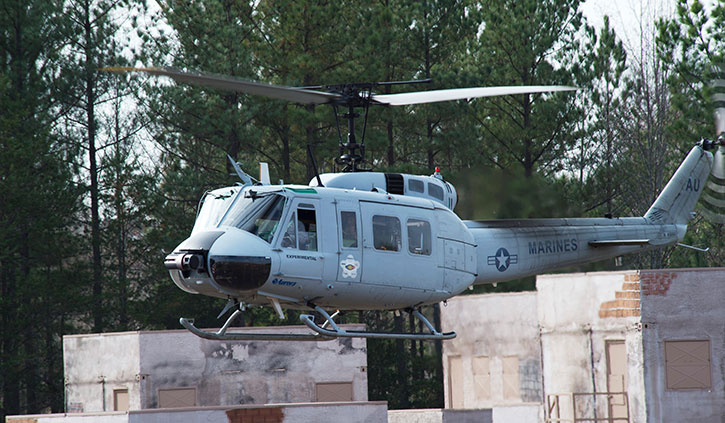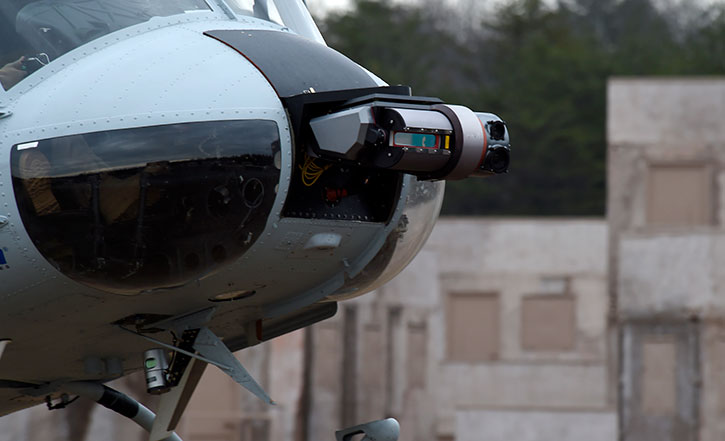The Marine Corps examined an innovative autonomous flying capability that enables troops to safely and reliably control helicopters from the ground, even in difficult weather conditions. The demonstration flight took place this week at the Marine Corps Base Quantico, Va., as the Office of Naval Research (ONR) announced the successful conclusion of the Autonomous Aerial Cargo/Utility System (AACUS) program.
The need for this capability surfaced during Marine Corps operations in Afghanistan and Iraq, experts say. Cargo helicopters and resupply convoys of trucks bringing fuel, food, water, ammunition and medical supplies to the front lines frequently found themselves under fire from adversaries—or the target of roadside bombs and other improvised explosive devices.
The AACUS-Enabled UH-1H (AEH-1) conducted multiple flights, showcasing its ability to autonomously execute re-supply missions in relevant and austere settings. The system consists of lidar and camera sensors and software package that detects and avoids obstacles and evaluates the landing zone. The system processes this information to perform onboard mission, route, and path planning to enable autonomous mission execution. The autonomy kit can be integrated into any manned or unmanned rotary-wing aircraft to detect and avoid obstacles (like telephone wires, other vehicles or large ground objects) in unfavorable weather conditions, or to facilitate autonomous, unmanned flight.

The AACUS suite enables a Marine on the ground to request a supply delivery via helicopter from a handheld tablet, requiring no advanced training to operate the system. “The Marines’ vision for the future of vertical lift operation and support is optionally-piloted aircraft,” said AACUS Program Manager Stephen Chisarik. “Aurora’s system enables any rotary-wing aircraft to detect and react to hazards in the flight path, and make appropriate adjustments to keep the aircraft safe.”
“This is more than just an unmanned helicopter,” said Dr. Walter Jones, ONR executive director. “AACUS is an autonomy kit that can be placed on any rotary-wing platform and provide it with an autonomous capability. Imagine a Marine Corps unit deployed in a remote location, in rough terrain, needing ammunition, water, batteries or even blood. “With AACUS, an unmanned helicopter takes the supplies from the base, picks out the optimal route and best landing site closest to the warfighters, lands, and returns to base once the resupply is complete—all with the single touch of a handheld tablet.”

“It can be used as a pilot aid to operate in GPS- and communications-denied arenas, or allow fully autonomous flights in contested environments—keeping our pilots and crews out of harm’s way.” Dennis Baker, AACUS program manager explained. Aurora has developed multiple technologies under the AACUS program: the digital flight control system which enables the UH-1 to fly autonomously; and the Tactical Autonomous aerial LOgistics System (TALOS) autonomy technology.
While previous demonstrations have showcased the system’s autonomy capabilities and interactions with trained operators, this was the first demonstration in which the aircraft performed cargo and utility missions in an operationally-relevant training environment with Marine interaction. As part of the demonstration, Marines loaded supplies for the aircraft before clearing the autonomy system for autonomous takeoff.
The AEH-1 was granted a Special Airworthiness Certificate by the Federal Aviation Administration (FAA) in October, allowing the aircraft to operate autonomously with only a safety pilot onboard to monitor the controls. Having completed the third and final phase of the program, AACUS will now transition to the Marine Corps for experimentation and potential acquisition.




















